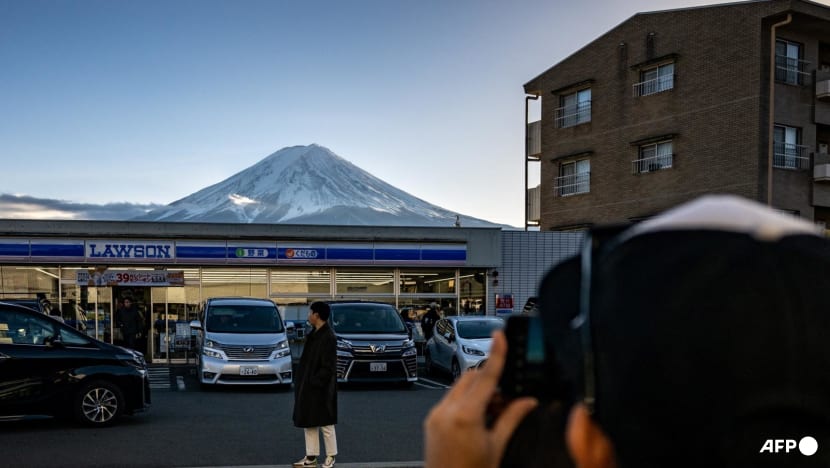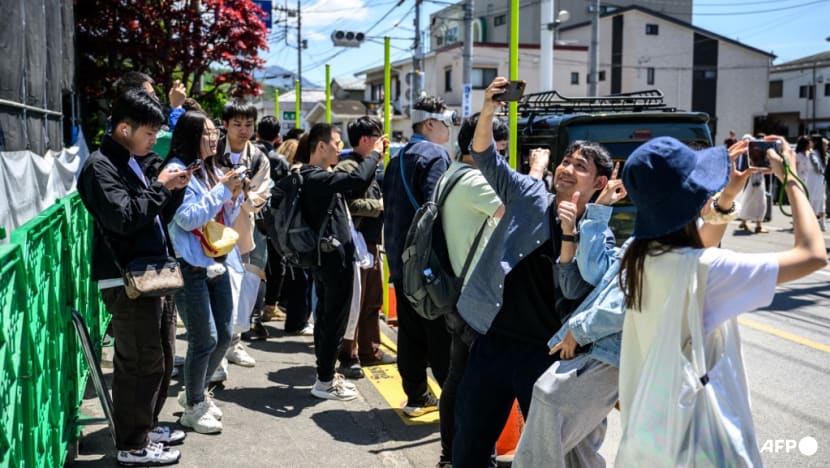Commentary: Mount Fuji overtourism furore tests limits of Japan’s hospitality
Japan is debating the limits of its famed hospitality as a rush of travellers, boosted by the weak yen, strains patience, says Gearoid Reidy for Bloomberg Opinion.

A tourist posing in front of a convenience store with Mount Fuji in the background, in the town of Fujikawaguchiko, Yamanashi prefecture on Jan 1, 2024. (File photo: AFP/Philip Fong)
TOKYO: The ukiyo-e artist Hokusai was famed for his Thirty-Six Views of Mount Fuji, woodblock prints deeply symbolic of Japan. But one famous view of the mountain, this time from the modern era, has just been blocked off.
Local authorities in Fujikawaguchiko, a holiday town in the mountain’s shadow, this week erected a barrier obstructing a sight of the landmark that, from the right angle, made it appear to float above a convenience store in perhaps the ultimate illustration of traditional and modern Japan.
Although it might have been gold for your Instagram, the rush of tourists wasn’t appreciated by residents, who complained that visitors were littering, blocking access to services used by residents and spilling out dangerously onto the road in the quest for the perfect shot.
The end result: Now no one gets to enjoy the view. It’s a solution to the problem that would make The Simpsons’ Mr Burns proud.

COURTESY MAY BE REACHING ITS LIMITS
The government has been promoting the country to foreign visitors for years with immense success: Arrivals this year are expected to surpass the 2019 pre-COVID record, according to travel agency JTB. Yet from increasingly unaffordable hotels to suitcase-clogged streets becoming nigh-unwalkable, everywhere you look the downsides are mounting for ordinary residents.
This dissatisfaction was articulated by one acerbic restaurant owner who last month took to social media to express mounting frustration with having to deal with tourists looking for English menus and service in their native language. The time and hassle involved in dealing with them didn’t make sense for travellers who don’t spend much anyway, the owner explained.
The complaints split opinion, with some sympathising, while others defended the country’s vaunted omotenashi hospitality - a word so synonymous with the Japanese welcome that it just made it into the Oxford English Dictionary ("good hospitality, characterised by thoughtfulness, close attention to detail, and the anticipation of a guest’s needs", in case you were wondering).
But just as in Fujikawaguchiko, that courtesy may be reaching its limits. Frustrated authorities and small-business owners are turning to new solutions to preserve their way of life.
In Kyoto, where overtourism is most acute, tourists have been banished from the backstreets of the geisha district of Gion (though it’s unclear how this will be enforced), while the city is belatedly adding special buses for travellers amid complaints that elderly residents can’t access public transport.
In Hiroshima, one restaurant serving the local soul food of okonomiyaki (coincidentally, another word just added to the dictionary) has declared visitors verboten on Friday evenings, limiting entrance to prefectural residents and regulars.
Part of the problem is that the pain of dealing with tourists is readily apparent, but the benefits - whether increased tax revenue or booming businesses - are often less visible. With about 40 per cent of visitors coming to Japan for the first time and social media pushing people to the same locations, some destinations are deserted while others are well past capacity.
Especially with the yen trading around 160 to the US dollar, foreigners can live like kings without spending that much at all. This exacerbates the frustration in a country where real wages have been stagnant for decades and are now declining.
And so many of the country’s iconic experiences, from the Mt Fuji convenience store to shooting video in Shibuya’s Scramble Crossing, simply don’t cost any money at all.
FAST PACE OF CHANGE
Japan is far from alone in grappling with this issue. Barcelona has removed a bus route from map apps due to overcrowding. Venice just introduced a €5 (US$5.40) entrance tax during peak hours.
Activists in Mallorca have even taken to erecting fake signs in English, hoping to scare off vacationers by warning them of nonexistent dangers (an approach I am seriously considering imitating in Shibuya).
But it’s the pace of change where things are different. Countries like Italy and Spain have had decades to get used to a tourist influx; Japan became one of the world’s most desired destinations practically overnight.
The number of visitors to those European countries grew by about 20 per cent between 2014 and 2019; in Japan, that figure more than doubled.
Locals had only just started to get used to the arrivals when the unforeseen interregnum of COVID-19, reducing visitors to practically zero. Their sudden return has only intensified residents’ discontent.
POSSIBLE QUICK WINS
Now the downsides keep stacking up. Hotel prices are surging, up 20 per cent from last year, leaving some business travellers struggling to find lodging. Hotels are finding it relatively easy to raise prices to cope with a growing labour shortage in the services sector. Other industries that don’t get a boost from tourist demand aren’t so lucky.
The country needs to grapple with these problems before overtourism replaces omotenashi. The weak yen might be a tailwind now, but more than 30 million people still visited Japan in 2019 even with the currency closer to 100 to the dollar.
There are a couple of possible quick wins. The country charges a paltry 1,000 yen (US$6.50) departure tax: That needs to be quadrupled or more. Ditto with the accommodation tax some areas charge, including Tokyo, levied at only 100 to 200 yen per night.
Services only used by foreigners should impose much higher prices, such as the 70 per cent increase levied last year on the Japan Rail Pass, a product only for tourists, which gives unlimited rides on the main Shinkansen line.
And the duty-free system, which exempts the 10 per cent consumption tax for purchases over 5,000 yen, has long since outlived its usefulness, with billions of yen being lost to scalpers. The system should be scrapped or the minimum spend hugely increased.
But ultimately, these are short-term solutions to make putting up with the pain a little easier. Japan needs fixes better than simply blocking everything off.
















